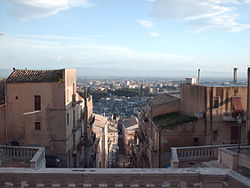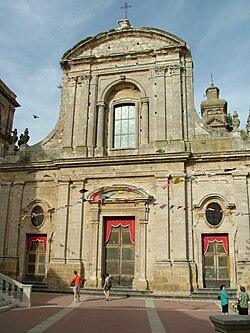Caltagirone
| Caltagirone | ||
|---|---|---|
| Comune | ||
| Città di Caltagirone | ||
 |
||
|
||
| Location of Caltagirone in Italy | ||
| Coordinates: 37°14′15″N 14°30′45″E / 37.23750°N 14.51250°ECoordinates: 37°14′15″N 14°30′45″E / 37.23750°N 14.51250°E | ||
| Country | Italy | |
| Region | Sicily | |
| Province / Metropolitan city | Catania (CT) | |
| Frazioni | Albanazzo, Colleggiata (Collegiata), Favarella, Granieri, Mulino Buongiovanni, Piano Carbone, Piano San Paolo, Rangasia, San Basilio - Casa Prete, San Mauro, Santo Pietro, Serra Fornazzo, Signore del Soccorso, Villa Gravina, Villa Grazia | |
| Government | ||
| • Mayor | Giovanni Ioppolo | |
| Area | ||
| • Total | 382 km2 (147 sq mi) | |
| Elevation | 608 m (1,995 ft) | |
| Population (31 December 2014) | ||
| • Total | 38,828 | |
| • Density | 100/km2 (260/sq mi) | |
| Demonym(s) | Calatini or Caltagironesi | |
| Time zone | CET (UTC+1) | |
| • Summer (DST) | CEST (UTC+2) | |
| Postal code | 95041, 95040 | |
| Dialing code | 0933 | |
| Patron saint | St. James | |
| Saint day | July 25 | |
| Website | Official website | |
| Late Baroque Towns of the Val di Noto (South-Eastern Sicily) | |
|---|---|
| Name as inscribed on the World Heritage List | |
| Location | Italy |
| Type | Cultural |
| Criteria | i, ii, iv, v |
| Reference | 1024 |
| UNESCO region | Europe and North America |
| Inscription history | |
| Inscription | 2002 (20th Session) |
Caltagirone (Sicilian: Caltaggiruni) is a town and comune in the Metropolitan City of Catania, on the island (and region) of Sicily, southern Italy, about 70 kilometres (43 mi) southwest of Catania. It is bounded by the comuni of Acate, Gela, Grammichele, Licodia Eubea, Mazzarino, Mazzarrone, Mineo, Mirabella Imbaccari, Niscemi, Piazza Armerina, San Michele di Ganzaria.
The city is a production center of pottery, particularly maiolica and terra-cotta wares. Nowadays the production is more and more oriented to artistic production of ceramics and terra-cotta sculptures. Other activities are mainly related to agriculture (production of grapes, olives, peaches).
The city's name derives from the Arabic "qal'at-al-jarar" ("Castle of [pottery] jars") - a name that attests to the antiquity of the pottery works which are still thriving. It has been inhabited since prehistoric times, as shown by the presence of two necropolises dating from the second millennium BCE and by numerous other archaeological finds. It was later inhabited by the Sicels pre-Roman population.
...
Wikipedia



